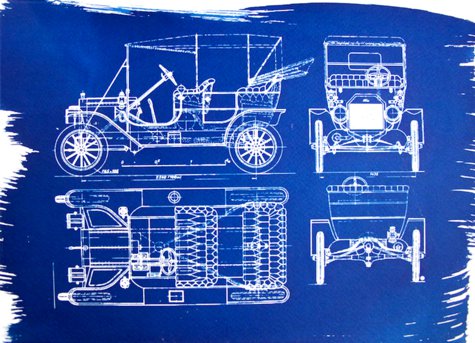
The cyanotype process, also known as the blue print process was invented by Sir John Herschel in 1842 and is still performed today by many darkroom enthusiasts. Herschel made numerous important contributions to photography. He made improvements in photographic processes, particularly in inventing the cyanotype process and variations (such as the chrysotype), the precursors of the modern blueprint process. He experimented with color reproduction, noting that rays of different parts of the spectrum tended to impart their own color to a photographic paper. He collaborated in the early 1840s with Henry Collen, portrait painter to Queen Victoria. Herschel originally discovered the platinum process on the basis of the light sensitivity of platinum salts, later developed by William Willis.
In 1861 Alphonse Louis Poitevin, a French chemist, found that ferro-gallate in gum is light sensitive. Light turns this to an insoluble permanent blue. A coating of this chemical on a paper or other base may be used to reproduce an image from a translucent document.
The ferro-gallate is coated onto a paper from aqueous solution and dried. The coating is yellow. In darkness it is stable for up to three days. It is clamped under glass and a light transmitting document in a daylight exposure frame, which is similar to a picture frame. The frame is put out into daylight requiring a minute or two under a bright sun or about ten times this under an overcast sky. Where ultra-violet light is transmitted the coating converts to a stable blue or black dye. The image can be seen forming, when a strong image is seen the frame is brought indoors and the unconverted coating, under the original image, is washed away. The paper is then dried.
The result is a copy of the original image with the clear background area rendered dark blue and the image reproduced as a white line. The image is stable.
Later other blueprint processes based on photosensitive ferric compounds were used. The best known is probably a process using ammonium ferric citrate and potassium ferricyanide. In this procedure a distinctly blue compound is formed and the process is also known as cyanotype. The paper is impregnated with a solution of ammonium ferric citrate and dried. When the paper is illuminated a photoreaction turns the trivalent (ferric) iron into divalent (ferrous) iron. The image is then developed using a solution of potassium ferricyanide forming insoluble ferroferricyanide (Turnball's blue identical to Prussian blue) with the divalent iron. Excess ammonium ferric citrate and potassium ferricyanide are then washed away.
This is a simple process for the reproduction of any light transmitting document. Engineers and architects drew their designs on cartridge paper; these were then traced on to tracing paper using Indian ink for reproduction whenever needed.
Traditional blueprints have largely been replaced by more modern, less expensive printing methods and digital displays. In the early 1940s, cyanotype blueprint began to be supplanted by diazo prints or whiteprints, which have blue lines on a white background; thus these drawings are also called blue-lines or bluelines. Other comparable dye-based prints are known as blacklines.
Diazo prints remain in use in some applications but in many cases have been replaced by xerographic print processes similar to standard copy machine technology using toner on bond paper. More recently, designs created using Computer-Aided Design techniques may be transferred as a digital file directly to a computer printer or plotter; in some applications paper is avoided altogether and work and analysis is done directly from digital displays. Another common modern method of copying is the use of large-format scanners. These digitize an image which can then be printed with a large-format plotter.
As print and display technology has advanced, the traditional term "blueprint" has continued to be used informally to refer to each type of image.
Source: Wikipedia.org


